Follow-up visit from Kyoto University - September 2013/November 2013
The Centre for Intelligent Sensing (CIS) welcomed Professor Tatsuya Kawahara, Professor Takashi Matsuyama, Professor Toyoaki Nishida and Dr Xuefeng Liang, visiting academics from Kyoto University, Japan. During the visits, technical discussions focused on Intelligent Sensing. CIS research results and projects were demonstrated to the KU's visitors who shared their views on the different topics and highlighted the common aspects existing on past and current projects at Kyoto University. Overviews of the labs at Kyoto University were offered in several research seminars.
Details of the programmes of each visit can be found at the below links.
[Programme 1]
[Programme 2]
More information on the past Kyoto University and Queen Mary University of London Symposium on Intelligent Sensing can be found [here]
|
Multi-Modal Sensing and Analysis of Poster Conversations
Professor Tatsuya Kawahara
Conversations in poster sessions in academic events, referred to as poster conversations, pose interesting and challenging topics on multi-modal signal and information processing.
This talk gives an overview of our project on the smart posterboard for multi-modal conversation analysis.
The smart posterboard has multiple sensing devices to record poster conversations, so we can review who came to the poster and what kind of questions or comments he/she made.
The conversation analysis combines speech and image processing such as head tracking, speech enhancement and speaker diarization.
Moreover, we are also investigating high-level indexing of interest and comprehension level of the audience, based on their multi-modal behaviors during the conversation.
|

|
|
Modeling Dynamics in 3D Video Production and Human Communication
Professor Takashi Matsuyama We have been studying models of dynamics to realize natural human-computer communication and have developed the following approaches. Firstly, 3D Video: this is not 3D-TV or 3D animation, but full 3D video of human activities such as dancing and sports. Secondly, Hybrid Dynamical Systems: these integrate both discrete-state based transitions like automata, and continuous physical dynamics, described by differential equations. This talk presents our research attainments in these two fields with basic ideas, technologies, and demo videos. |
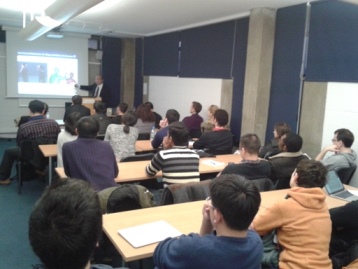
|
|
An engineering approach to conversational informatics – towards conversational intelligence
Professor Toyoaki Nishida People are very proficient in collaboratively forming and maintaining gatherings thereby shaping and cultivating collective thoughts through fluent interactions. Conversational informatics is a field of research that focuses on investigating conversational interactions and designing artifacts that can interact with people in a conversational fashion. In this talk, I will overview our approach aiming at building a conversationally intelligent system in which the engineering aspects of conversational informatics is emphasized. First, I will introduce conversation quantization, a conceptual framework that underlies our approach. In contrast to conversational systems for which much emphasis has been placed on the symbolic processing and algorithms, our approach is data-intensive, allowing for the conversational system to acquire the depth and proficiency in interaction in an incremental fashion, in addition to the broad coverage and robustness. Then, I will present smart space for allowing people to prosume conversation in a cyber-physical space, computer-vision for helping conversational intelligence prosume conversational content, content measurement analysis and modeling, learning by demonstration for conversational intelligence to autonomously learn conversation, and cognitive design for communicating tacit intentions. |
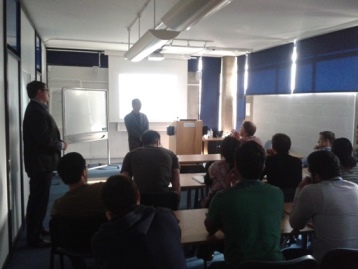
|

|
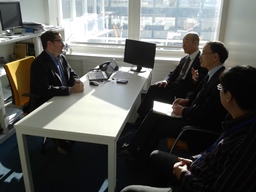
|
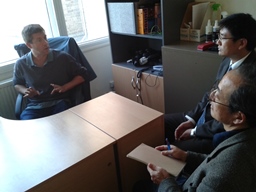
|
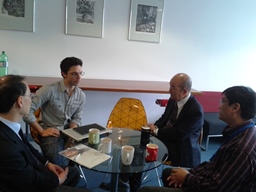
|
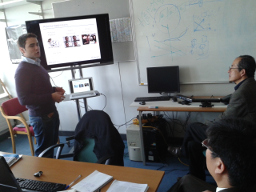
|

|
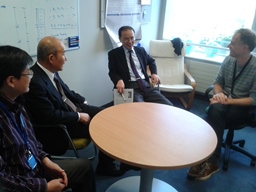
|
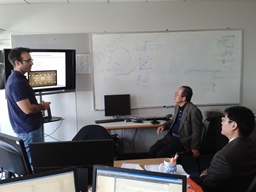
|
We would like to thank the following people that were involved in the discussions with the visitors: Eliane L Bodanese, Andrea Cavallaro (and his PhD student: Fabio Poiesi and his Post-docs: Juan Carlos SanMiguel, Tsz-Kin Hon), Félix Cuadrado, Hatice Gunes (and her PhD student: Evangelos Sariyanidi), Hamed Haddadi, Miles Hansard, Timothy Hospedales (and his PhD students: Yi Li, Alex Xun Xu, Zhiyuan Shi), Ioannis Patras (and his PhD student: Heng Yang), Mark Plumbley, Stefan Poslad, Matthew Purver (and his PhD student: Julian Hough and his Post-doc: Christine Howes), Josh Reiss, Fabrizio Smeraldi, Laurissa Tokarchuk, and Tao Xiang.